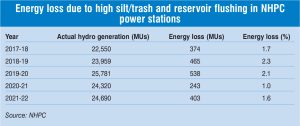The operations and maintenance (O&M) of hydroelectric plants (HEPs) is critical for meeting grid requirements, ensuring proper functionality and minimising downtime. Hydropower projects are capital-intensive assets, and well-maintained hydro assets have a longer life compared to other energy sources. The best O&M practices in the hydropower segment include analysis of the operational parameters of a plant on a daily basis, tripping and breakdown analysis, technical inspection and dam safety inspection, silt/sediment management, and critical spares and inventory management. Further, digitalisation of HEPs is useful for optimising O&M, besides helping cut costs and increasing the effectiveness of workforce management. Digitalisation is also useful in the integration of HEP operations with other variable renewable energy sources, since digital solutions help in closely monitoring HEP operations.
A look at some of the best practices and solutions for hydropower O&M…
Best O&M practices
Analysis of operational parameters of plants on a daily basis: An analysis of the operational parameters of the generating unit with reference to the inflow, water utilisation, reservoir level, spillage, etc. must be regularly carried out. Regular inspection of a plant’s equipment should be carried out and the records of such inspections should be invariably maintained by noting all the details, normal or abnormal. Any abnormality in the system should be analysed and appropriate actions should be considered.

Tripping and breakdown analysis: Power stations must be regularly monitored for forced outages/breakdowns, and tripping/breakdown analysis of each event must be carried out to identify the root cause of the fault to ensure early restoration. The power station must then be intimated about corrective action and restorative works to avoid and minimise the reoccurrence of tripping/breakdowns. Such analysis has helped NHPC reduce forced outages to 0.46 per cent in 2021-22 from 0.93 per cent in 2017-18.
Technical inspection and dam safety inspection: To maintain the health of equipment and installations, as well as for proper record keeping, storage of spares and compliance with safety norms, technical inspection and dam safety inspection must be carried out at all power stations. Monitoring the health and maintenance of civil structures at power stations is crucial for the overall performance of the power stations. To this end, the technical inspection of all power plants should be conducted by the O&M team while dam safety inspections should be conducted by the design and engineering team.
Silt/Sediment management: The Himalayan region carries huge amounts of sediment during the monsoon season. Over 80 per cent of the average annual sediment comes during this season. Hydro-abrasive erosion is a common form of damage suffered by many NHPC plants, such as the Salal Dulhasti, Chamera-II, Dhauliganga, Teesta-V and Baira Siul HEPs, which are situated on rivers that carry excessive amounts of hard particles such as quartz, mica, feldspar and muscovite. These hard particles flow with high velocity, and damage the underwater components of hydro turbines. An effective sediment management system is needed to safeguard the health of a reservoir.
 To resolve the issue of sedimentation or silt erosion, various mitigation techniques can be adopted. Abrasion can be avoided or delayed by using material that matches the hardness of quartz particles. Additionally, the underwater parts (runners and guide vanes) can be coated with high pressure high velocity oxygen fuel to mitigate abrasion and erosion. The trailing edges of runner blades are particularly prone to damage due to their thinness. The severe loss of material along the length of the blades can result in the loss of up to 3 per cent of the original runner weight after every season. Typically, a properly repaired and coated runner can last three seasons, whereas an uncoated runner does not last more than one season. Silt also impacts the auxiliary equipment in a hydropower plant. Cooling water pipes in guide bearings, generator transformers, etc. can get eroded and choked due to the presence of silt. The clogging of these pipes affects cooling and causes an increase in temperature, leading to forced outage of the machine. Further, sediment erosion is a big issue for the draft tube section, which is closer to the runner, as it is exposed to the highest velocity of water. Often, the mechanical shaft seals get damaged when exposed to sand-laden water. This damage is more due to abrasion than erosion. Apart from the selection of erosion- and abrasion-resistant material for seals, the insertion of pressurised clean water in the shaft seal also prevents damage. This has minimised the failure of shaft seals at NHPC’s Dulhasti and Teesta-V power stations. Additionally, at NHPC’s Tanakpur power station a separate cooling pond has been made, which reduces the impact of silt during the monsoon.
To resolve the issue of sedimentation or silt erosion, various mitigation techniques can be adopted. Abrasion can be avoided or delayed by using material that matches the hardness of quartz particles. Additionally, the underwater parts (runners and guide vanes) can be coated with high pressure high velocity oxygen fuel to mitigate abrasion and erosion. The trailing edges of runner blades are particularly prone to damage due to their thinness. The severe loss of material along the length of the blades can result in the loss of up to 3 per cent of the original runner weight after every season. Typically, a properly repaired and coated runner can last three seasons, whereas an uncoated runner does not last more than one season. Silt also impacts the auxiliary equipment in a hydropower plant. Cooling water pipes in guide bearings, generator transformers, etc. can get eroded and choked due to the presence of silt. The clogging of these pipes affects cooling and causes an increase in temperature, leading to forced outage of the machine. Further, sediment erosion is a big issue for the draft tube section, which is closer to the runner, as it is exposed to the highest velocity of water. Often, the mechanical shaft seals get damaged when exposed to sand-laden water. This damage is more due to abrasion than erosion. Apart from the selection of erosion- and abrasion-resistant material for seals, the insertion of pressurised clean water in the shaft seal also prevents damage. This has minimised the failure of shaft seals at NHPC’s Dulhasti and Teesta-V power stations. Additionally, at NHPC’s Tanakpur power station a separate cooling pond has been made, which reduces the impact of silt during the monsoon.
Critical spares and inventory management: Sometimes the performance of HEPs is affected by the non-availability of critical high-value spares. These high value spares have higher lead times due to the manufacturing cycle. The remote location of most HEPs further aggravates the problem. Hence, it is imperative that critical spares are identified and proper inventory management is undertaken. Notably, NHPC has identified the critical spares for each power station, along with the minimum/maximum inventory and reorder levels. Each power station is required to maintain a minimum critical inventory level to ensure uninterrupted operations.
Digitalisation of HEPs
The use of digital tools in the O&M of HEPs is gaining traction. One of the key upcoming technologies for digital operations in the hydropower segment is digital twins. Digital twins create virtual HEPs that, through artificial intelligence (AI), machine learning (ML) and mathematical models, mimic the behaviour of a real plant. This allows operators to analyse the plant’s performance in real time, through simulations, and predictive and preventive analytics.
Internet of things is the key technology solution for digitalising the operations of HEPs. Deploying sensors across a plant helps gather real-time data on plant performance and ambient conditions. Sensors embedded in assets are useful for measuring key parameters such as wear and tear, and temperature. This facilitates real-time asset health monitoring, allowing for more granular insight into asset performance trends.
Supervisory control and data acquisition (SCADA) systems are an integral part of hydropower plant automation. A SCADA system allows power plant operators to perform several plant operations remotely, such as opening/closing valves/switches and monitoring alarms. It is used to control, monitor and analyse devices and processes. This system enables remote and on-site data collection, allowing developers to access and control turbine data without being on site, and allowing companies to manage their HEPs remotely.
Other tools widely deployed to digitalise the operations of HEPs include computational fluid dynamics to make internal flow predictions with high accuracy; and distributed control systems, which involve networks of instrumentation comprising sensors, flow switches, transducers, etc., and provide real-time information to operators. Further, drones, and AI- and ML-enabled technologies are being used for remote monitoring purposes.
Conclusion
The O&M needs of hydropower plants located in Himalayan topology primarily concerns mitigation of the challenges posed by sediments in the inflow. The knowledge accrued over the years, information sharing, and advancements in technology and accessibility to it have facilitated the adoption of O&M best practices. This has been reflected in the continual improvement in the performance of NHPC’s power stations.
Moreover, hydropower projects in hilly regions are more vulnerable to cloudbursts and flash floods. Therefore, it is necessary to set up early warning systems (EWSs) to avoid losses due to these disasters. An EWS enables the local administration and people to evacuate before a flood. Around 47 projects/power stations (including 10 HEPs of NHPC and two HEPs of Chenab Valley Power Projects Limited) have been identified as vulnerable. NHPC Limited has implemented EWS at nearly every project. NHPC had been given the responsibility, by the Ministry of Power, of establishing an EWS master control room catering to all hydro projects of its own as well as of other gencos in the upper Himalayan region. The company has established this master control room at its Faridabad office, with 24×7 real-time monitoring and alert generation mechanisms.
Net, net, the adoption of the best O&M practices at HEPs optimises operations and maximises the life and reliability of the plants. Operators are increasingly focusing on adopting new-age and digital O&M technologies for superior power plant O&M.
Based on a presentation by NHPC Limited at a recent Power Line conference



